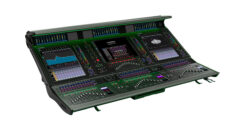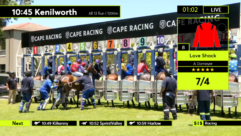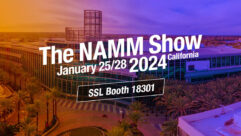
Technology Showcase:
Live Digital Mixing Consoles
Dec 1, 2006 12:00 PM,
By Daniel Keller
New mixers incorporate intuitive workflows to rival their analog counterparts.

Digico D5 Live
Although digital technology has long been a fact of life in the audio kingdom, its adaptation has conspicuously lagged behind in the world of front-of-house consoles. For most live sound engineers, the rationale behind sticking with analog has always come down to workflow — paging through menus just doesn’t cut it in the instantaneous, muscle-memory world of FOH. It’s a shame, really, since so much of what’s good about digital is so well suited to mixing live sound. Features like snapshot recall, onboard DSP, and flexible bussing, for starters, are ideal solutions for the compressed schedules and limited real estate conditions endemic to live sound.
Until fairly recently, live engineers wanting to go digital had only a few options, most of them fairly high end and high budget. Thankfully, the past couple of years have seen the emergence of a new generation of live digital consoles covering a wide range of configurations and price points. This year’s AES show was flush with live mixers that are powerful, well designed, and within the reach of more moderately sized venues and tours.
The offerings are varied and impressive, but it’s the design of the user interface that sets these boards apart from mere repurposed studio consoles. Clearly, these manufacturers understand that to win over the live sound engineer, features are important, but intuitive workflow is the Holy Grail.
AN OVERVIEW
This issue, we’ve put together a brief overview of some of the digital mixers currently available that target the live sound arena exclusively or primarily. The list is hardly comprehensive, and the market is one of the most rapidly growing and changing sectors in the industry, so check the manufacturers’ websites for full information.

Cadac S-Digital
The Allen and Heath iLive is targeted at the live sound, theater, and contractor markets, and offers a flexible architecture with distributed audio and control. The iLive design separates the control surface and processing rack into discrete units with the iDR-64, a rackmounted modular mix engine, connecting to the control surface via Ethernet and EtherSound. This allows the unit to reside onstage, where it hosts a configurable range of up to 48 analog and digital inputs and outputs. The processor offers up to 32 mixes, assignable as main, groups, auxes, or matrix, as well as an array of DSP devices to provide channel and mix processing; speaker processing; and an array of effects, dynamics, and EQ.
The control surface is available in three configurations — the iLive-112 (28 faders, 112 channel strips); the iLive-144 (36 faders, 144 channel strips); and the iLive-176 (44 faders, 176 channel strips). All versions of the control surface have a distinctly analog workflow, with four layers of faders and illuminated LCD channel strip displays and an LCD touchscreen for quick access to some functions.
Cadac has long been a major player in the theater market, and its recently introduced S-Digital console continues that focus. While most current digital mixers employ interfaces derived, at least to some degree, from digital recording desks, the S-Digital’s design and surface architecture strongly suggest Cadac’s popular J-Type analog mixer.
In its basic configuration, the S-Digital offers a minimum specification of 72 input channels, 66 mix busses, and three stereo listen busses. The control surface is configured as three integrated components — Input Frame, Output Frame, and Central Control Module — with a single input frame capable of controlling 144 input channels, and a single output frame handling 72 output and listen busses. Multiple control surfaces can be configured within a system, allowing control over all parameters from several locations, such as FOH, monitors, and control room. All input and output modules are hot-swappable, and the system employs a proprietary high-speed communications protocol to link the control surface with the processor rack and multiple audio I/O racks.
Digico’s D5 Live has been a favorite of many high-end tours, and with good reason. The D5 offers a wide range of features: an intuitive, logical workflow, and an easy-to-navigate interface. Four color LCD touchscreens give the desk a good tactile and visual functionality. Other features include an electronic scribble strip, multiple display modes, and easy access to all fader parameters via a combination of onscreen buttons and surface hardware controls.
The D5 can control up to 48 input channels, and also features a 17-channel master section on its control surface. The desk is available in 56- and 112-input configurations, and the console is LCR and 5.1 surround compatible and equipped with three panning joysticks. The onstage DigiRack contains analog I/O connections, as well as 56 A/D and eight D/A converters.
Digico also offers the D1 Live, a smaller console with 40 inputs and 24 outputs that is compatible with its DigiRack. The D1 Live handles 64 channels and can be expanded up to 160, with six independent DSP units for dynamics, EQ, and effects.
Long a household name in studio recording software and hardware, Digidesign upped the ante in the industry last year with the introduction of its Venue product — the company’s first console designed specifically for live applications.
Venue’s modular system design is comprised of several configurable components. The expandable D-Show mixing console connects via digital snake system to the FOH rack, where the expandable DSP mix engine lives, and to the Stage rack, offering up 48 remote-controlled mic preamps and A/D converters. The system can run 64 input channels and provide more than enough multiband EQ and DSP plug-ins for dynamics and effects.
Not surprisingly, Venue offers direct integration with Pro Tools, enabling live multitrack recording directly from FOH, as well as full compatibility with TDM effects plug-ins.
Digidesign has also introduced the D-Show Profile, a more compact version of the D-Show, aimed at nightclubs, theaters, and churches. The Profile is designed to connect to the same FOH and Stage racks, offering a comparable feature set and processing power in a smaller footprint.
Harrison’s Trion is designed for a wide range of applications, and much of its feature set is well suited for live work. The mixer can handle from 32 to an unlimited number of channels, each with 16 or 32 aux sends and up to 96 bus assignments. Channel controls can be laid out vertically or spread across eight faders for deeper access, and the mixer can provide on-stage monitor mixes from a stage-side remote controller.
One nice touch is the console’s PreView display, which offers an overview of a selected channel’s name, stem assignments, EQ and dynamics, routing, and metering, as well as a scrolling 20-second waveform view.
By dedicating more real estate to hands-on faders, Innovason has designed live consoles that are well liked by hands-on live engineers. The company’s Sy80 unit offers 80 physical channel faders, each with LED meter, mute, cue, and select switches. A central channel control section handles deeper parameters for any selected channel. Faders are fully configurable as inputs, VCAs, groups, busses, auxes, or any other function. The console provides 104 inputs into 48 mix busses, with up to 40-bit internal processing, and a full overview of the entire mix is accessible via a single button.
The more compact Sy48 hosts 48 faders that can mix 72 inputs into 40 busses. Although both mixers connect to external I/O modules, the Sy48 offers 16 local I/Os and digital I/O onboard. Both mixers feature 12in. fold-down screens, selectable monitoring options, and snapshot recall, as well as programming and synchronization features useful in theater applications.
Well known in European broadcast and theater communities for its high-end consoles, the Swiss company Lawo has been gaining in popularity with live sound engineers. The company’s mc290 and mc266 consoles are available in frame sizes up to 104 faders, with 40-point signal processing for up to 512 channels on the mc290 and 192 channels on the mc266, both with 144 summing busses. Both desks offer 32 aux sends, a sophisticated DSP, a routing matrix with 8,192 possible crosspoints, and support for multiple surround modes.
The mixers’ control surfaces can be configured via eight-fader modules, with the mc266 topping out at 48 + 8 faders and the mc290 handling up to 96 + 8, or 192 + 8 on a doubled fader bay. And Lawo uses a star-link configuration for all console modules, allowing any configuration to be changed during operation without noise or data loss.
Until recently, live digital mixing was largely the province of deep-pocketed tours and venues, a fact that changed with the introduction of Mackie’s TT24. The TT24 is a small but powerful console aimed squarely at small- to mid-sized venues with an eye on the budget. It features 24 input channels with rear-panel mic/line inputs and TRS insert points, as well as multiple ADAT and 2-channel digital inputs. The control surface offers 24 touch-sensitive faders and multi-function V-Pots, as well as five group and master faders. Any channel can be selected for deeper control of other parameters via the center channel, and every channel offers four-band EQ, dynamics, 12 aux sends, and comprehensive routing.
The TT24’s interface is nicely intuitive, with quick access to virtually every task. The master section features a 5in. touchscreen, three 31-band EQs, and a wide selection of DSP effects and dynamics. A USB port provides connectivity to a PC running Mackie’s TT-Control software for full control over all mixer parameters.
The Midas XL8’s large-format, high-end design has made it a popular choice among major tours and venues. The mixer’s tactile architecture is familiar and easy to navigate using selectable colored LEDs for faders and groupings, and third-party hardware and software plug-ins are easily integrated with the desk’s open architecture.
Each mic input features three discrete mic preamps to eliminate output sharing, and each of the 96 input channels offers multiband EQ and an impressive range of dynamics. Routing and grouping are fully flexible, with 32 aux and 16 matrix busses, and the XL8 packs a powerful DSP engine to easily handle an array of high-quality plug-ins and effects.
Jointly developed with sister company Studer, Soundcraft’s Vi6 borrows many of Studer’s interface features, including color touchscreens with integrated rotary encoders and switches mounted on the glass, making for exceptionally intuitive operation. The Vi6 handles 64 channels, mapped to two layers of its 32 faders, which are assignable to 32 outputs. All functions are always displayed on each channel strip, and are selected by touching the element on screen. Fader groups and functions are displayed with color-coded LEDs for easy visibility. Each input channel offers four-band parametric EQ, and the mixer is packed with a range of dynamics and effects DSP.
Two separate racks house the stagebox and local DSP rack, providing onstage connectivity and processing respectively. Both boxes connect to the mixer surface via redundant Cat-5 cables. Not surprisingly, the Vi6 is fully compatible with parent company Harman’s HiQnet proprietary network system, allowing the mixer to function as a central control point for any of Harman’s wireless microphone systems, signal processors, amplifiers, or loudspeakers.
Here’s another well-kept secret for budget-minded live engineers: Although they’re marketed as recording boards, Tascam’s DM-3200 and the newer DM-4800 are well-suited for live mixing applications. With their small footprints, flexible operation, and low price, these mixers have become a popular choice in small- to mid-sized venues.
Weighing in at only 70lbs., the DM-4800 is a self-contained console that offers 24 busses, 12 sends, and 16 returns, along with 24 mic/line inputs, and all the expected digital features, such as snapshot recall and built-in DSP. It also boasts a row of multimode LED ring encoders, which can easily be configured to control a second fader layer, providing direct access to 48 channels without switching layers.
Yamaha was among the first out of the gate in the world of digital mixers, and the company’s product line ranges from small-format portables to large-scale touring consoles. Its latest offering, the LS9, is a mid-sized desk available in 16- and 32-fader models. Inputs on both models can be doubled using expansion cards to create 32- and 64-channel mixers packed with a respectable helping of DSP muscle.
For slightly larger mid-range applications, the M7CL is available in 32- and 48-channel configurations. Expandable to 40 and 56 channels respectively, the M7CL’s control surface uses double fader bays to offer 32 or 48 dedicated channel faders, along with four group and eight master faders. Both units have 16 mix busses and eight matrix channels, along with four effects processors and eight 31-band EQs.
The PM5D is one of Yamaha’s flagship consoles, available with 48 channels of standard or recallable-gain mic preamps. Its 24 faders can handle up to 64 inputs, with 24 submaster or aux busses. Eight independent multi-effects processors are onboard, and the console supports multiple surround modes and has a 500-scene memory. Yamaha has also just introduced the DSP5D, a rackmounted version of the PM5D, which can be used to double the functionality of an existing unit.
Another well-established Yamaha standard is the PM1DV2, a large-format console that handles 96 channels with 48 mix busses. Its CS1D control surface has 48 input channel faders and a powerful master control and data entry section.
Yamaha also offers several smaller footprint digital mixers popular in theater and worship venues, including the DM2000, the DM1000, and the 02R96.
For More Information
Allen and Heath
www.allen-heath.com
Cadac
www.cadac-sound.com
Digico
www.digico.org
Digidesign
www.digidesign.com
Harrison
www.glw.com
Innovason
www.innovason.com
Lawo
www.lawo.ca
Mackie
www.mackie.com
Soundcraft
www.soundcraftdigital.com
Tascam
www.tascam.com
Yamaha
www.yamahaca.com
Daniel Kelleris an audio industry veteran and principal of Get It In Writing. From tour buses to aux busses, he has survived many a format war and spewed obscenties at analog and digital equipment alike.










